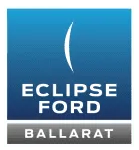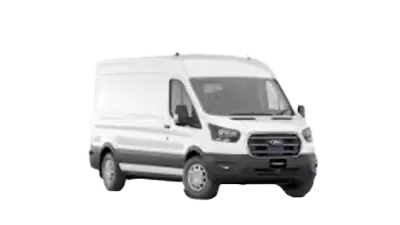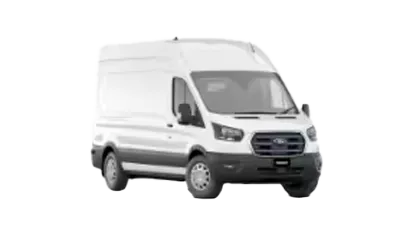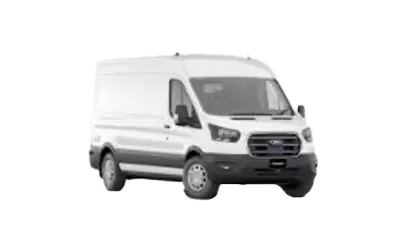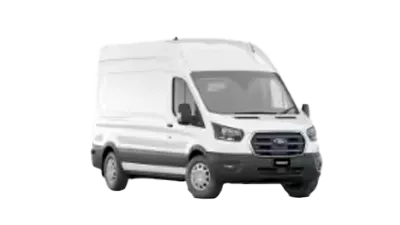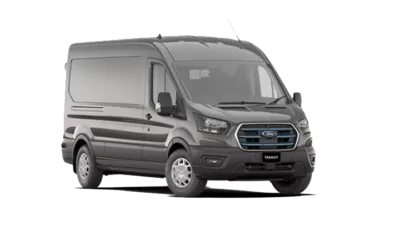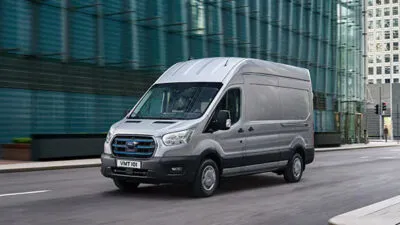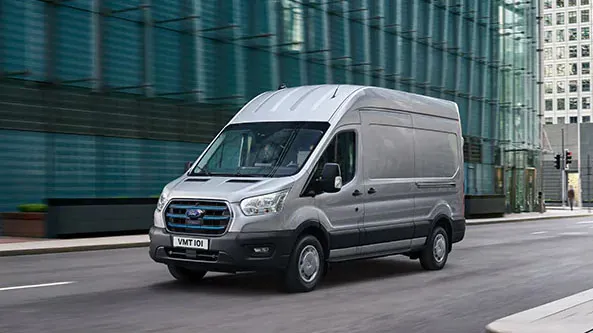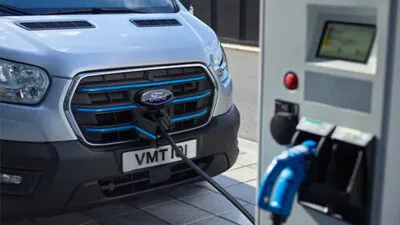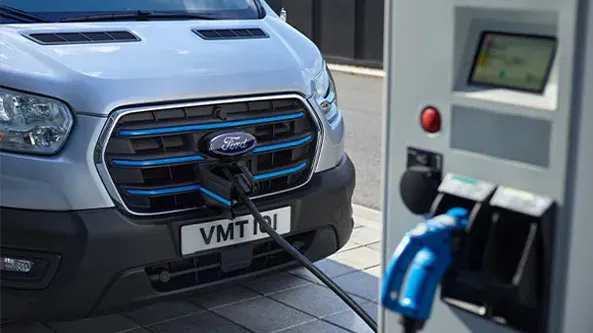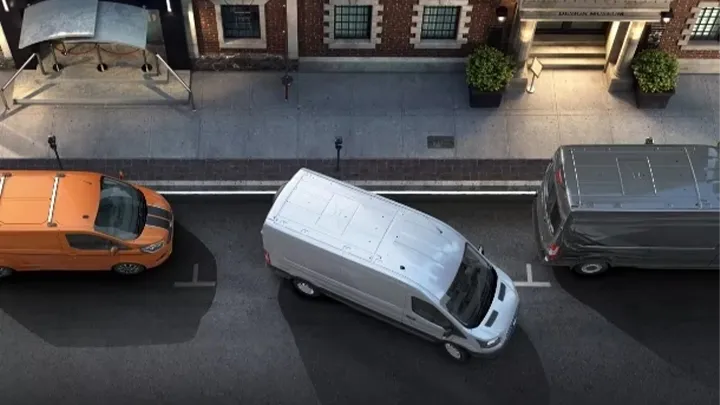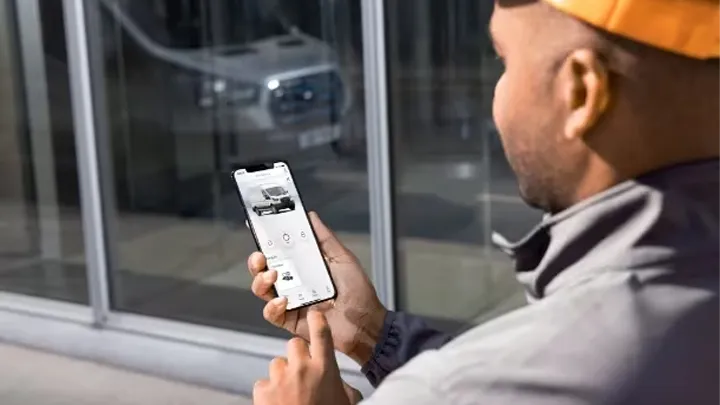[1] Based on full charge of E-Transit Van 420L. Estimated range using Worldwide Harmonised Light Vehicle Test Procedure (WLTP). Figures shown are for comparability purposes and should only be compared with other vehicles tested to the same technical procedures. Actual range varies with conditions such as external elements like temperature, driving behaviours, route profile, load, vehicle maintenance, and lithium-ion battery age and condition. WLTP Overall Range reflects a combined driving cycle. This test is conducted in controlled conditions with an ambient temperature of 23 degrees Celsius and no climate or electrical load. Maximum driving range for E-Transit Van without the high roof option.
[2] Calculated via peak performance of the electric motor(s) at peak battery power. Individual results may vary.
[3] Maximum load volume method simply measures the volume of a fine-grained material such as sand or rice which can be deposited into the loadspace. Load Area Protection Kit may impact cargo area dimensions and capacities. Dimensions and capacities are approximate and subject to individual vehicle variances and should be confirmed before fitting any accessories or otherwise relying on this value.
[4] Subject to State and Territory regulations. Payload is defined as the Gross Vehicle Mass minus the kerb weight. Payload is the maximum combined value of occupants, cargo, added options and added structures. GVM must not be exceeded.
[5] Indicative AC Charging time quoted is using 3-phase charger at 11kW for E-Transit Van 420L. Charge power can decrease with increasing state of charge. Actual charge times and charge speeds can vary based on different factors (e.g. weather, temperature, driving behaviour, route profile, vehicle condition, age and condition of the lithium-ion-battery and used charging infrastructure). E-Transit comes equipped with a Type 2, Mode 3, 32-amp charge cable as standard. This cable requires a wall charger box to charge at home (not supplied) or can be used at a public charger.
[6] Indicative charging performance using a DC Fast Charger at 115 kW for E-Transit Van 420L. Charge power can decrease with increasing state of charge. Actual charge times and charge speeds can vary based on different factors (e.g. weather, temperature, driving behaviour, route profile, vehicle condition, age and condition of the lithium-ion-battery and used charging infrastructure). E-Transit comes equipped with a Type 2, Mode 3, 32-amp charge cable as standard. This cable requires a wall charger box to charge at home (not supplied) or can be used at a public charger.
[7] Driver-assist features are supplemental and do not replace the driver’s attention, judgment and need to control the vehicle. May not operate at certain speeds, or in certain driving, road or weather conditions. See Owner’s Manual for more information. Speed Sign Recognition will not always detect the correct speed limit and may display...
[1] Based on full charge of E-Transit Van 420L. Estimated range using Worldwide Harmonised Light Vehicle Test Procedure (WLTP). Figures shown are for comparability purposes and should only be compared with other vehicles tested to the same technical procedures. Actual range varies with conditions such as external elements like temperature, driving behaviours, route profile, load, vehicle maintenance, and lithium-ion battery age and condition. WLTP Overall Range reflects a combined driving cycle. This test is conducted in controlled conditions with an ambient temperature of 23 degrees Celsius and no climate or electrical load. Maximum driving range for E-Transit Van without the high roof option.
[2] Calculated via peak performance of the electric motor(s) at peak battery power. Individual results may vary.
[3] Maximum load volume method simply measures the volume of a fine-grained material such as sand or rice which can be deposited into the loadspace. Load Area Protection Kit may impact cargo area dimensions and capacities. Dimensions and capacities are approximate and subject to individual vehicle variances and should be confirmed before fitting any accessories or otherwise relying on this value.
[4] Subject to State and Territory regulations. Payload is defined as the Gross Vehicle Mass minus the kerb weight. Payload is the maximum combined value of occupants, cargo, added options and added structures. GVM must not be exceeded.
[5] Indicative AC Charging time quoted is using 3-phase charger at 11kW for E-Transit Van 420L. Charge power can decrease with increasing state of charge. Actual charge times and charge speeds can vary based on different factors (e.g. weather, temperature, driving behaviour, route profile, vehicle condition, age and condition of the lithium-ion-battery and used charging infrastructure). E-Transit comes equipped with a Type 2, Mode 3, 32-amp charge cable as standard. This cable requires a wall charger box to charge at home (not supplied) or can be used at a public charger.
[6] Indicative charging performance using a DC Fast Charger at 115 kW for E-Transit Van 420L. Charge power can decrease with increasing state of charge. Actual charge times and charge speeds can vary based on different factors (e.g. weather, temperature, driving behaviour, route profile, vehicle condition, age and condition of the lithium-ion-battery and used charging infrastructure). E-Transit comes equipped with a Type 2, Mode 3, 32-amp charge cable as standard. This cable requires a wall charger box to charge at home (not supplied) or can be used at a public charger.
[7] Driver-assist features are supplemental and do not replace the driver’s attention, judgment and need to control the vehicle. May not operate at certain speeds, or in certain driving, road or weather conditions. See Owner’s Manual for more information. Speed Sign Recognition will not always detect the correct speed limit and may display a speed that is above or below the actual speed limit. In some circumstances Speed Sign Recognition will use map data to display the speed limit on the digital instrument cluster. Ford recommends keeping map data updated by fully activating the vehicle’s FordPass Connect modem and enabling Connected Navigation Services. Connected Navigation Services are included for 1 year from the Ford Express New Vehicle Warranty start date and available ongoing subject to payment of a subscription fee.
[8] Adaptive Cruise Control has a minimum operating speed of 30km/hr.
[9] Intersection Assist does not detect all vehicles in intersection, pedestrians or cyclists. It does not replace safe driving.
[10] Use of FordPass is subject to the FordPass Terms and Privacy Policy available on ford.com.au/fordpass and requires a compatible mobile device, internet access and software (including software updates from time to time). FordPass functionality and appearance may change over time due to software updates. You are responsible for internet access, mobile network data and voice call services required for your use of the FordPass App on your mobile device, including associated fees. The FordPass App and FordPass Connect modem can only work when both are connected to the telecommunications network. The FordPass Connect modem will only function on the 3G or 4G telecommunications networks. When these networks are no longer available, the modem will stop functioning and the connected services and all data transmission via the modem will cease. Ford cannot guarantee that FordPass will be in fully operating condition at all times and the FordPass App may be unavailable or particular FordPass services interrupted. Ford is not responsible for any limitations or restrictions of the telecommunications network or of your mobile device. Warning: Local laws prohibit some phone functions while driving. Check your local road rules before using these functions. Use Remote Vehicle Start and Stop responsibly and only in well ventilated areas where you are aware of your vehicle’s surroundings.
[11] Don’t drive distracted. Use voice operated systems where possible and don’t use handheld devices while driving. Some features may be locked out while the vehicle is in gear. Not all SYNC features are compatible with all phones. SYNC screen appearance and functionality may change over time due to software updates.
[12] Apple CarPlay / Android Auto requires phone with compatible version of Apple iOS / Android™ (as applicable), active data service, and connection cable (sold separately). SYNC® does not control Apple CarPlay / Android Auto while in use. Apple / Google and other third parties are responsible for their respective functionality. Message and data rates may apply. Apple CarPlay, Siri Eyes Free, iPod and iPhone are trademarks of Apple Inc. registered in the US and other countries. Android Auto and Google Maps are trademarks of Google Inc. Ford Applink® is available on selected SYNC® models and is compatible with select smartphone platforms. Warning: Local laws prohibit some phone functions while driving. Check your local road rules before using these functions.
[13] Warranty conditions apply. Our goods come with consumer guarantees that cannot be excluded under the Australian Consumer Law. Our warranty does not limit and may not exceed your rights under those guarantees. See https://www.ford.com.au/owners/warranties/ for warranty terms.
Available to order. Additional wait times may apply.

